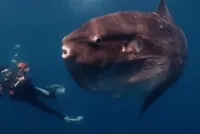Mystic Aquarium
Misquamicut beachgoers experienced a bit of newsworthy
excitement last week. A fin was spotted bobbing at the water’s surface
just beyond the buoy marker designating the beach’s swim area – a mere 150 feet
from the shore.
What was initially deemed a shark sighting, causing lifeguards to restrict water access for a few hours, turned out to be something equally mysterious but completely harmless to humans.
 |
| Sunfish, no threat... |
What was initially deemed a shark sighting, causing lifeguards to restrict water access for a few hours, turned out to be something equally mysterious but completely harmless to humans.
On
the heels of Discovery Channel’s Shark Week programming, initial eyewitness
reports and video suggested the fin belonged to a shark.
However, the Rhode
Island Department of Environmental Management’s Division of Marine Fisheries
examined captured footage and was able to confirm that the fin in question
belonged to an ocean sunfish, or mola mola.
 |
| ...Versus shark |
“I
actually thought sunfish for a minute after seeing the video,” said Dr. Jen
Flower, Mystic Aquarium’s Chief Clinical Veterinarian, “just because of the
erratic movements at the surface.
This swimming pattern would be a bit unusual for a shark as they don’t often make such quick changes in direction at the surface.”
This swimming pattern would be a bit unusual for a shark as they don’t often make such quick changes in direction at the surface.”
Further research supports Dr. Flower’s observations.
According to the New England Basking Shark & Ocean Sunfish Project’s website (nebshark.org), ocean sunfish often swim on their side, repeatedly lifting their elongated, pointed dorsal fin in and out of the water – a behavior that is unique to the fish and known as skulling. The site further designates the difference between shark and sunfish fin movements:
If
you see the dorsal fin cutting smoothly through the water in a forward motion,
then you are looking at a basking shark. If, on the other hand, you see that
the dorsal fin is being skulled above the water’s surface, then you are looking
at an ocean sunfish.
The
ocean sunfish can be found in all tropical and temperate ocean zones, including
off the coast of New England.
In fact, sunfish sightings are common in our area, as are strandings along the northern shores of Cape Cod, MA, from late August through December when sunfish begin their migration south and become trapped by the bay’s hook-like geography – something that has also hindered migration patterns of area turtle populations.
In fact, sunfish sightings are common in our area, as are strandings along the northern shores of Cape Cod, MA, from late August through December when sunfish begin their migration south and become trapped by the bay’s hook-like geography – something that has also hindered migration patterns of area turtle populations.
Known
as the world’s heaviest bony fish, ocean sunfish can grow to be 10 feet and
weigh nearly 2,000 pounds. The fish is a slow and cautious swimmer with fins
that are extremely powerful, allowing it to dive to depths of more than 2,000
feet – they can even breach the water’s surface.
While not a threat to humans, the opposite can be said for the sunfish; spending much of its time sunning near the ocean’s surface makes it vulnerable to boat strikes and becoming bycatch in fishing net.
Another human-influenced danger to sunfish comes in the form of marine debris. Discarded plastic bags floating in the ocean closely mimic the motion and appearance of one of the sunfish’s primary prey: sea jellies.
“It’s
important to be knowledgeable about marine species native to our ocean waters
and respect their environment, especially if you plan on swimming in their
habitat,” added Dr. Flower.
“Of course, when a fin is spotted close to shore, it’s always best to play it safe and evacuate the water. While most finned animals – including sharks – do not pose a threat to humans, there is no predicting their behavior or response to something new.”
“Of course, when a fin is spotted close to shore, it’s always best to play it safe and evacuate the water. While most finned animals – including sharks – do not pose a threat to humans, there is no predicting their behavior or response to something new.”